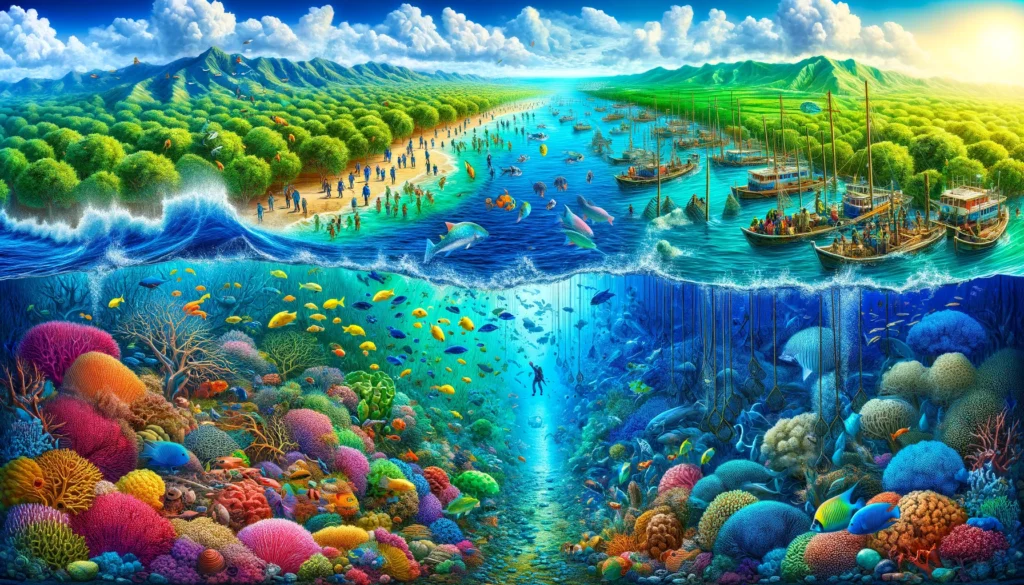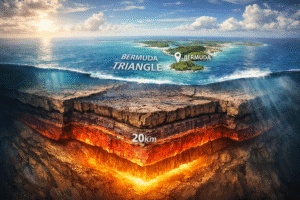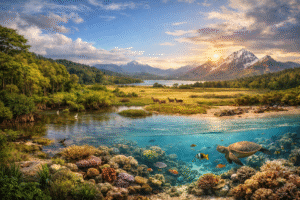Imagine waking up one day to find that iconic coastal cities, places once bustling with life and steeped in history, have begun to vanish beneath the relentless waves. This scenario, once the reserve of science fiction, is inching closer to reality as the specter of climate change looms larger with each passing year. The economic ramifications of this unfolding crisis touch every corner of our globe, from the bustling markets of Europe to the serene beaches of São Tomé and Príncipe.
But what if I told you that within this daunting challenge lies a story not just of loss and despair but of resilience, innovation, and unexpected heroes? This blog post embarks on a journey to uncover the economic impacts of climate change on coastal economies, weaving through a tapestry of data, personal stories, and innovative solutions that shine a light on humanity’s capacity to adapt and thrive in the face of adversity.
As we navigate through alarming statistics, case studies, and voices from the front lines, we’ll discover that the battle against climate change is not just about surviving; it’s about transforming our world in ways we never thought possible. So, take a deep breath, and let’s dive into a story of challenge, change, and hope that awaits us.
Climate Change on Coastal Economies
As we peel back the layers of our story, we find ourselves confronting the stark reality of numbers that refuse to be ignored. The economic toll of climate change on coastal economies is a tale of staggering losses, threatened livelihoods, and the urgent need for adaptation. From the vibrant alleys of European coastal towns to the serene shores of the Adriatic, the ripple effects of our warming planet are leaving an indelible mark on economies that have thrived on the edge of land and sea for centuries.

Key Statistics and Findings:
- EU & UK Economic Losses: Imagine the collective wealth of nations, years of progress, being eroded away to the tune of EUR 871.8 billion by 2100 under a high-emission scenario. This isn’t just a figure; it’s a glaring signpost pointing towards a 1.26% GDP loss compared to what could have been—a future where we dared to act sooner.
- Regional GDP Losses: Picture the coastal regions in Poland and Italy, where communities have woven their lives around the ebb and flow of the tide. In places like Zachodniopomorskie, Pomorskie, Veneto, and Emilia-Romagna, GDP losses loom large, forecasting a future where the very fabric of these communities could be altered beyond recognition, with losses up to 20.84%.
The Price of Resilience:
In the face of these daunting figures and forecasts, the story bends towards the monumental efforts required for adaptation and resilience. This isn’t merely about weathering the storm; it’s a profound transformation of how we interact with our coastal environments. The costs associated with bolstering our public infrastructure against the dual threats of current and future flood scenarios are monumental, yet indispensable. While exact figures are challenging to pin down, the consensus is unanimous: the investment in resilience is not just expensive—it’s a critical lifeline for our coastal communities.
The dialogue around resilience is evolving from questions of “How much will it cost?” to “Can we afford not to?” The financial burden of adaptation, though hefty, pales in comparison to the cost of inaction. It’s a harsh reminder that the investments we make today in strengthening our sea walls, redesigning our cities, and innovating flood defense mechanisms are not just expenditures; they’re the seeds for a sustainable future—a future where coastal economies don’t just survive but thrive in harmony with the natural forces that once threatened their very existence.
Through this lens, “The Price of Resilience” is not just a financial figure. It’s a testament to our collective will to innovate, adapt, and forge a path forward that respects the delicate balance between human ambition and the natural world. The true cost of resilience, then, is measured not in currency, but in our commitment to safeguarding our communities for generations to come.
The Blue Economy at Risk
Venturing deeper into our narrative, we arrive at the heart of coastal economies—the Blue Economy. This vast, teeming network of life and commerce, encompassing fisheries, aquaculture, and ecosystem services, stands at the precipice, facing unprecedented threats from climate change. The interplay of rising sea temperatures, acidification, and extreme weather events poses not just an ecological crisis but a severe economic one, affecting millions who depend on the ocean’s bounty for their livelihoods and sustenance.

Fisheries and Aquaculture: A Lifeline in Peril
- Global Livelihoods: Picture the lives of around 600 million people, a significant portion of humanity, intricately linked to fisheries and aquaculture. These sectors are not merely economic activities; they are the bedrock of food security, cultural heritage, and community identity in many parts of the world.
- Sustainable Practices: The paradox of overfishing reveals a counterintuitive truth—a World Bank study suggests that fishing less could actually lead to a 40% increase in the global landed value of fish. This insight opens up a vista of possibilities for sustainable fishing practices that not only preserve biodiversity but also bolster economic resilience.
Coastal Ecosystem Services: Unsung Heroes
- Carbon Sequestration: Coastal ecosystems, with their mangroves and seagrass meadows, are unsung heroes in the fight against climate change. Their ability to sequester carbon far surpasses that of terrestrial forests, offering a natural buffer against global warming.
- Flood Protection and Biodiversity: Beyond carbon, these ecosystems provide critical services in flood protection, soil stabilization, and as nurseries for marine life. Their preservation is not just an environmental imperative but an economic one, safeguarding the very foundations of coastal economies.
Adaptation and Mitigation Strategies
As the narrative unfolds, we delve into the realm of hope and action—how coastal economies and communities worldwide are not just facing up to the challenges posed by climate change but are actively seeking solutions through adaptation and mitigation strategies. These efforts highlight a collective determination to reimagine our relationship with the coastlines that cradle our civilizations.

Building Resilience Through Strategic Adaptation
- Coastal Protection Measures: From the construction of sea walls to the nourishment of beaches, communities are deploying a range of engineering marvels and nature-based solutions to shield themselves from erosion and rising tides. These measures are more than just barriers; they are testaments to human ingenuity and versatility.
- Nature-Based Solutions: Emphasizing the role of mangroves, coral reefs, and wetlands not only underscores their ecological importance but also their economic value in protecting coastlines, reducing flood risks, and supporting fisheries. Investing in these natural defenses is an investment in the future resilience of coastal economies.
Policy and Community Action: The Twin Pillars of Change
- Economic Diversification: Reducing reliance on vulnerable sectors by diversifying into other areas of economic activity offers a pathway to resilience. This strategy not only mitigates risk but also opens new avenues for growth and development.
- Policy Support: Enacting and enforcing policies that promote sustainable development, environmental conservation, and disaster risk reduction are crucial. These frameworks guide actions, shape behaviors, and ensure a coordinated response to the challenges at hand.
Lessons from Past Responses
- Community Engagement: Successful adaptation strategies often hinge on community engagement. When local knowledge and participation guide the development of solutions, the outcomes are more sustainable and effective.
- Integrated Management Approaches: Addressing the environmental, economic, and social dimensions of coastal challenges through integrated management approaches enhances resilience, showcasing the power of holistic thinking in the face of complex problems.
Spotlight on São Tomé and Príncipe
Diving into a specific narrative, we turn our attention to São Tomé and Príncipe, an island nation in Central Africa that epitomizes the complex interplay between environmental sustainability and economic survival. This small island state, rich in biodiversity and cultural heritage, faces the immense challenge of balancing development with the preservation of its natural resources in the age of climate change.
São Tomé and Príncipe (STP) stands out as among the nations most susceptible to the impacts of Climate Change, primarily because of its geographical layout and unique attributes, characterized by the fragility of its ecosystems and its relatively low level of socio-economic development. The country is currently experiencing adverse effects from rising temperatures and prolonged dry periods, resulting in various natural calamities including flash floods, storms, sea-level rise, coastal erosion, and droughts.

Facing Environmental Challenges Head-On
- Community Concerns and Government Action: A recent Afrobarometer survey reveals a profound concern among São Toméans regarding pollution and environmental degradation, with a significant majority calling for more robust government action. This collective voice underscores a critical awareness and desire for sustainable governance.
- Economic vs. Environmental Priorities: The survey also highlights a societal crossroads—balancing economic growth with environmental protection. While a portion of the population advocates for prioritizing jobs and income, there’s a substantial push towards environmental policies, even if they come at the cost of immediate economic gains.
The Path Forward: Adaptation and Empowerment
- Regulation and Natural Resource Management: With only 28% of São Toméans seeing the benefits of natural resource extraction as outweighing its negatives, there’s a clear mandate for stricter environmental regulations. This perspective not only reflects a protective stance towards the island’s natural heritage but also a strategic approach to ensuring long-term economic sustainability.
- Community Engagement: The belief in shared responsibility for reducing pollution, with nearly half attributing this duty to citizens themselves, highlights the potential for community-driven environmental initiatives. This shared responsibility paves the way for innovative local solutions to global challenges, emphasizing the power of collective action.
Community Engagement in Action
As we near the conclusion of our journey, it’s crucial to zoom out and recognize the global tapestry of communities rising to meet the challenges of climate change. Across continents, from the tropics to the temperate zones, people are not merely waiting for solutions to descend from above; they are crafting their own, rooted in local knowledge and driven by the urgency of their circumstances.

Global Examples of Resilience and Innovation
- Public Health and Climate Change in Sri Lanka: In Sri Lanka, Public Health Midwives (PHMs) have redefined their roles to become agents of change, integrating climate resilience into their community health initiatives. This proactive approach has bolstered the community’s ability to respond to health challenges exacerbated by climate change, showcasing the power of integrating climate action with public health.
- WASH Implementation in Kupang City, Indonesia: The focus on Gender Equality and Social Inclusion (GESI) in the implementation of Water, Sanitation, and Hygiene (WASH) programs in Kupang City highlights the importance of considering the most vulnerable in climate adaptation efforts. Community participation has been key to enhancing the resilience and effectiveness of these essential services.
- Combating Dengue in North Maluku, Indonesia: In the Tidore Islands City, the community’s response to the rising threat of Dengue Hemorrhagic Fever, fueled by climate change, emphasizes the necessity of coordinated efforts, from preventive measures to community education. This example underlines the critical need for adaptation strategies that address public health in the context of a changing climate.
- Sustainable Livelihoods in the Limpopo River Basin: The Limpopo River Basin (LRB) spans across Southern Africa as a transboundary river basin, ranking as the fourth largest international basin in the region, with a total area of 416,296 km2. This basin is jointly shared by Botswana, Mozambique, South Africa, and Zimbabwe. The exploration of timber and non-timber forest products in the Limpopo River Basin sheds light on the importance of sustainable management and utilization of natural resources. Community-based approaches have proven essential in ensuring livelihoods while contributing to climate change adaptation.
Conclusion: A Tapestry of Resilience and Hope
As we draw the curtains on our exploration of the economic impacts of climate change on coastal economies and the myriad ways in which communities around the globe are responding, it’s clear that this story is far from over. What began as a journey through the daunting statistics and forecasts has blossomed into a narrative rich with examples of resilience, innovation, and collective action.

The challenges posed by climate change are immense, touching every corner of our planet and every facet of our lives. Yet, in the face of these challenges, there emerges a common thread that binds us all—a shared determination to seek solutions, adapt, and thrive. From the bustling streets of European coastal cities to the serene shores of São Tomé and Príncipe, from the resilient communities in Sri Lanka to the innovative initiatives in Indonesia, the message is clear: we are not passive observers of our fate.
This global tapestry of adaptation and mitigation strategies, underpinned by community engagement and policy support, offers a beacon of hope. It showcases not just what is at stake, but what is possible when we come together to confront the challenges of our time. The road ahead is undoubtedly long and fraught with obstacles, but it is also paved with opportunities for transformation and growth.
Call to Action: Joining Hands for a Sustainable Future
As readers of this narrative, our role is not merely to witness but to participate. Each of us holds the power to contribute to this global effort, whether through individual actions, community involvement, or advocacy for stronger policies. The fight against climate change is a collective endeavor, one that requires us to harness our creativity, our passion, and our resolve.
Let us take inspiration from the stories shared in this blog and seek out ways to make a difference in our own communities. Whether it’s supporting sustainable practices, engaging in local conservation projects, or simply raising awareness about the issues, every action counts. Together, we can forge a path toward a more resilient, sustainable, and equitable future for all.
Author’s Note
This exploration has been a reminder that climate change is not just a story of environmental shifts; it’s a narrative deeply intertwined with our economies, livelihoods, and cultures. The stories of adaptation and resilience shared here are testaments to the human spirit’s capacity to confront adversity with hope and action.
The fight against climate change is a shared journey, one that requires each of us to contribute in whatever way we can. Let’s continue to inspire and support each other in building a sustainable future for our planet.
G.C., Ecosociosphere contributor.
References
- Unlocking Economic Unity: The Digital Economy’s Impact on Market Segmentation in China
- Portraying the Bangladesh Shrimp Industry: A SWOT Analysis
- Spatial-temporal evolution characteristics and spillover effects of carbon emissions from shipping trade in EU coastal countries
- São Toméans look to government, one another for action on the environment
- COMMUNITY-DRIVEN SALTY URBANISM: COMBATING COASTAL EROSION
- Mobilising Communities Prior to Healthcare Interventions: Reflections on the Role of Public Health Midwives Working With Vulnerable Communities of Sri Lanka
- A new approach towards a user-driven coastal climate service to enhance climate resilience in European cities





Comments
Thank you for your sharing. I am worried that I lack creative ideas. It is your article that makes me full of hope. Thank you. But, I have a question, can you help me?
Thanks for sharing. I read many of your blog posts, cool, your blog is very good.
I don’t think the title of your article matches the content lol. Just kidding, mainly because I had some doubts after reading the article.